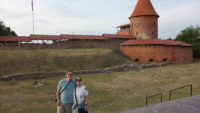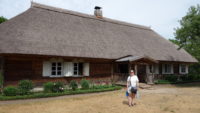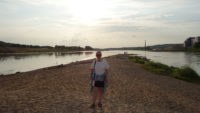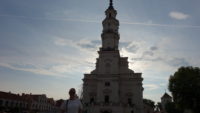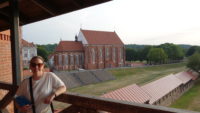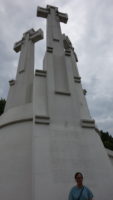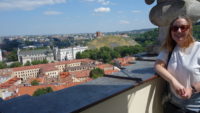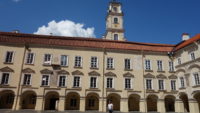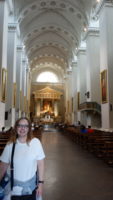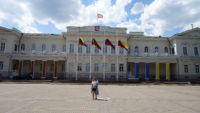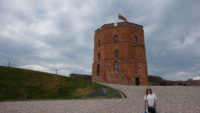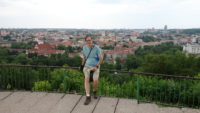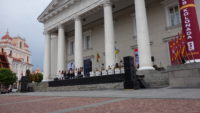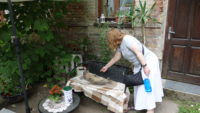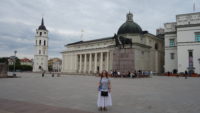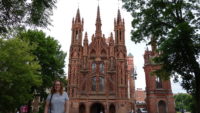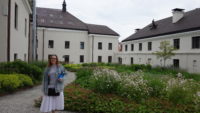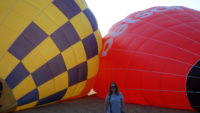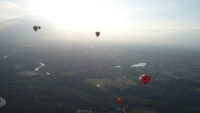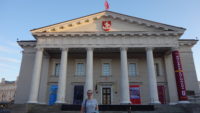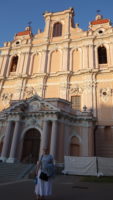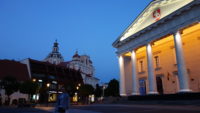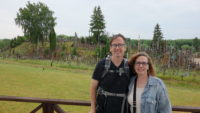 Meredith’s Mistake Maxim: when you travel, you will waste time and/or money. You just need to accept it and try to correct what you can.
Meredith’s Mistake Maxim: when you travel, you will waste time and/or money. You just need to accept it and try to correct what you can.
We left Kaunas in a steady rain this morning. Mer was in charge and tried to program my GPS to go to our next site in the north. There were two of them, so she guessed at one. It was north and the right distance away, so off we went.
Mer gets sleepy in cars, so I let her doze on and off over the next hour. We came to a blocked road, and while I asked the GPS to get us around it, Meredith became suspicious of where we were. She grabbed our paper map (it’s like a GPS, but you can’t zoom) and looked at the two sites. We were headed to the wrong one, a mistake that would take forty-five extra minutes to correct. She spent a good chunk of that time wondering why she hadn’t just looked at the map in the first place, but who would have guessed there would be two places with the same name, both in the north, both the correct distance away, but still fairly far apart? I told Mer that maybe the rain would stop in the extra forty-five minutes.
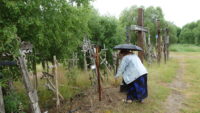 We got to our destination with no further issues. We arrived at Kryzių Kalnas, the Hill of Crosses. Just north of the town of Siauliai is a hill covered in approximately 200,000 crosses. No one is sure how it started, but by the time the Soviets rolled in in the 1940s, there were over 400 crosses there. The Soviets removed them. The locals replaced them. Five times the Soviets removed the crosses, bulldozed the hill, covered the area in sewage, and finally gave up in 1985 because the locals kept replacing them. The hill has become a symbol for Lithuanian independence.
We got to our destination with no further issues. We arrived at Kryzių Kalnas, the Hill of Crosses. Just north of the town of Siauliai is a hill covered in approximately 200,000 crosses. No one is sure how it started, but by the time the Soviets rolled in in the 1940s, there were over 400 crosses there. The Soviets removed them. The locals replaced them. Five times the Soviets removed the crosses, bulldozed the hill, covered the area in sewage, and finally gave up in 1985 because the locals kept replacing them. The hill has become a symbol for Lithuanian independence.
One very cool thing is that the rules governing the site allow anyone to place a cross anywhere, as long as it is under two meters (6.5 feet) tall, and as long as it doesn’t destroy previously placed crosses. This included nailing or hanging smaller crosses on existing bigger ones. Mer had very cleverly brought a cross with us from home, so she placed it in one of the “arms” that extend from the hill.
It was still raining when we got there, but not enough to interfere with touring the site. We were there about ninety minutes, and the rain lessened until it finally stopped about forty-five minutes in. That was nice.
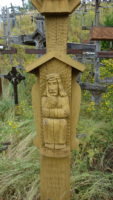 Several of the crosses had the “distressed Christ,” which seems to be a Lithuanian image of Jesus. We’ve never seen it anywhere else, but have seen multiple examples here over the last few days. It is an image of Jesus, sitting down, leaning his head against his right hand, and looking sad.
Several of the crosses had the “distressed Christ,” which seems to be a Lithuanian image of Jesus. We’ve never seen it anywhere else, but have seen multiple examples here over the last few days. It is an image of Jesus, sitting down, leaning his head against his right hand, and looking sad.
Several of the NATO air squadrons had erected crosses for their air groups while stationed at the nearby airbase. There was an intricate life-sized version of St. Francis. Someone had made a cross out of bicycle gears. Many crosses were decorated with folk carvings. There was a hidden “cave” made by the branches of a fir tree that was filled with crosses. There was a cross made from a computer memory stick, and one made of nails nailed into a board.
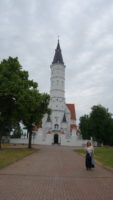 The site itself is much larger than I thought. As I mentioned, there are two arms of crosses that extend out from the hill. Except for footpaths, the hill itself is largely covered, and I was surprised that when I got to the top to find that the hill was a saddle – there were two hilltops joined by a low area. I have to admit to a certain satisfaction that the Soviets tried to get rid of Christianity, and the hill still stands while the USSR is long gone. “…I will build my church; and the gates of hell shall not prevail against it.”
The site itself is much larger than I thought. As I mentioned, there are two arms of crosses that extend out from the hill. Except for footpaths, the hill itself is largely covered, and I was surprised that when I got to the top to find that the hill was a saddle – there were two hilltops joined by a low area. I have to admit to a certain satisfaction that the Soviets tried to get rid of Christianity, and the hill still stands while the USSR is long gone. “…I will build my church; and the gates of hell shall not prevail against it.”
We then headed into the town of Siauliai, where we will be for two nights. We checked into our hotel, meeting an American named Ryan (or “Red”), who is a defense contractor here. He couldn’t tell me much about what he did, but he had tons of recommendations for the town since he has been here several times. He was most kind.
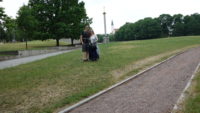 We walked into the town itself, passing the huge steeple of the Cathedral of Saints Peter and Paul. We headed down a bunch of stairs, passing a number of Communist-era concrete apartment buildings, until we got down to a park area. In the middle was an enormous pillar with a golden archer standing on top – Sundial Square. The 60-foot-high column is part of a huge sundial, which commemorates the 750th anniversary of the city. That’s pretty awesome.
We walked into the town itself, passing the huge steeple of the Cathedral of Saints Peter and Paul. We headed down a bunch of stairs, passing a number of Communist-era concrete apartment buildings, until we got down to a park area. In the middle was an enormous pillar with a golden archer standing on top – Sundial Square. The 60-foot-high column is part of a huge sundial, which commemorates the 750th anniversary of the city. That’s pretty awesome.
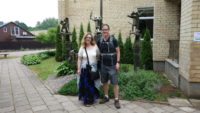 We kept on walking, passing a very pretty lake which had buoys set up for rowing races, and climbed a hill to get to the far side of the center of town. Mer took me back into a housing area to see… Katinų Muziejus – the Cat Museum! A whole museum dedicated to kitties! The museum had over six thousand representations of our favorite felines, from figurines to paintings to toys to mugs. Just as importantly, there were six museum kitties roaming around, although we only saw five of them. Two were very friendly. Good kitties! There was also a small separate room containing some exotic birds and reptiles and other small animals, which was fun, but we all know who the six real stars of the museum are. We spent about an hour there.
We kept on walking, passing a very pretty lake which had buoys set up for rowing races, and climbed a hill to get to the far side of the center of town. Mer took me back into a housing area to see… Katinų Muziejus – the Cat Museum! A whole museum dedicated to kitties! The museum had over six thousand representations of our favorite felines, from figurines to paintings to toys to mugs. Just as importantly, there were six museum kitties roaming around, although we only saw five of them. Two were very friendly. Good kitties! There was also a small separate room containing some exotic birds and reptiles and other small animals, which was fun, but we all know who the six real stars of the museum are. We spent about an hour there.
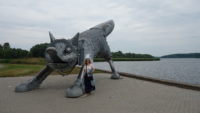 We headed back down to the lake, just strolling. Down by the lake was a family park, and like the park in Kaunas, it had workout equipment, a huge playground, outside ping pong tables, wooden lounge chairs, and even a small bike track with banked corners and small bumps to jump over. It seems Lithuanians love their parks and do them very well.
We headed back down to the lake, just strolling. Down by the lake was a family park, and like the park in Kaunas, it had workout equipment, a huge playground, outside ping pong tables, wooden lounge chairs, and even a small bike track with banked corners and small bumps to jump over. It seems Lithuanians love their parks and do them very well.
We finished the evening by walking the pedestrian-only main shopping street and getting something to eat in a very cool brick cellar restaurant. We walked back to our hotel by going through a wooded park, which was full of carved wooden sculpture,
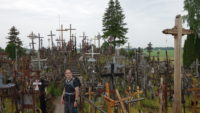 In the end, we got everything done today that Meredith had wanted to do, even with the delay, and that delay is what allowed us to have rain-free time at the Hill of Crosses. Sometimes mistakes get made, and those mistakes help make the day.
In the end, we got everything done today that Meredith had wanted to do, even with the delay, and that delay is what allowed us to have rain-free time at the Hill of Crosses. Sometimes mistakes get made, and those mistakes help make the day.
